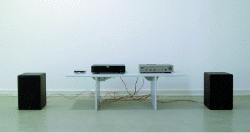Dave Allen
Halle fur Kunst, Luneburg, Germany
Halle fur Kunst, Luneburg, Germany

What is the attraction of music? Dave Allen has made his work an ongoing exploration of just this question. For his installation The Mirrored Catalogue d'Oiseaux (2002) Allen travelled back into the history of Modernism to focus on the work of influential dodecaphonic composer Olivier Messiaen. In the first exhibition space Messiaen's Catalogue d'Oiseaux (Catalogue of Birds, 1956-8) was playing on a stereo. It's a piece for which the composer taped hundreds of bird calls and used their rhythm, colour and texture as key compositional elements. It was first performed on solo piano in 1959 by Yvonne Loriod, the pianist for whom Messiaen wrote his music - and with whom he was unhappily in love.
Half of the adjacent exhibition space was taken up by a spacious aviary, which housed two live mockingbirds separated by a wire-netting partition in the middle. Allen thus set up a 'what if' scenario: what if the mockingbirds, famous for their ability to imitate other species, mimicked Messiaen's music, which in turn imitated bird-songs? An experiment about representation in music, a hall of mirrors - or rather, echoes - that paid tribute to Marcel Broodthaers. Beyond this speculative dimension, however, the live performance of the birds was amazing. On the opening night both seemed positively jet-lagged. Not a peep could be heard from them. But in the days that followed they started singing and became more sociable. They found a way of slipping through the partition and showed all the signs of a serious romance: sometimes sharing one space harmoniously, at other times splitting up to perch in opposite corners of their individual cages. So Allen's reflection on music became not just a narrative about natural and conceptual mimickry but also a sub-plot about love.
As you listened to the birdsong and the music, you could also read an assortment of texts about mockingbirds and the life and work of Messiaen. Here another intriguing aspect of Modernist music embracing ornithology emerged. Contrary to the 'back to nature' Folk spirit one would have expected, Messiaen's conceptual writing comprised a systematic translation of the natural into the technical. The diagrams of birdsongs he used as the structural foundation of his music, for instance, look like electronic circuit diagrams of synthesizers. So, in Messiaen's music a romantic enchantment by birdsong went together with a scientific drive to order and rationalize the object of his fascination.
Allen allowed the viewer a lot of room to manoeuvre. Shifting your attention from the music on the hi-fi to the birds in the aviary to the writings and back again, you would continuously pick up new threads and make new connections. The openness of the piece marks an interesting shift in Allen's work. Many of his earlier explorations of the thrills of music were firmly grounded in adolescent rites of fan culture, laddism and rock bands. In recent pieces this claim for authenticity has been replaced by something more speculative and detached, yet also more fundamental: an inquiry into the origins of the fascination of music. Instead of recognizable answers, Allen now presents cross-references, shifting metaphors and suggestive questions. Why do birds sing? Why do composers compose? What do Messiaen and mockingbirds have in common? They are artistic virtuosi. They relate to the world through imitation. They make music to communicate and mimic the sounds they like, to charm the ones they love. A list to be continued ad infinitum.






















